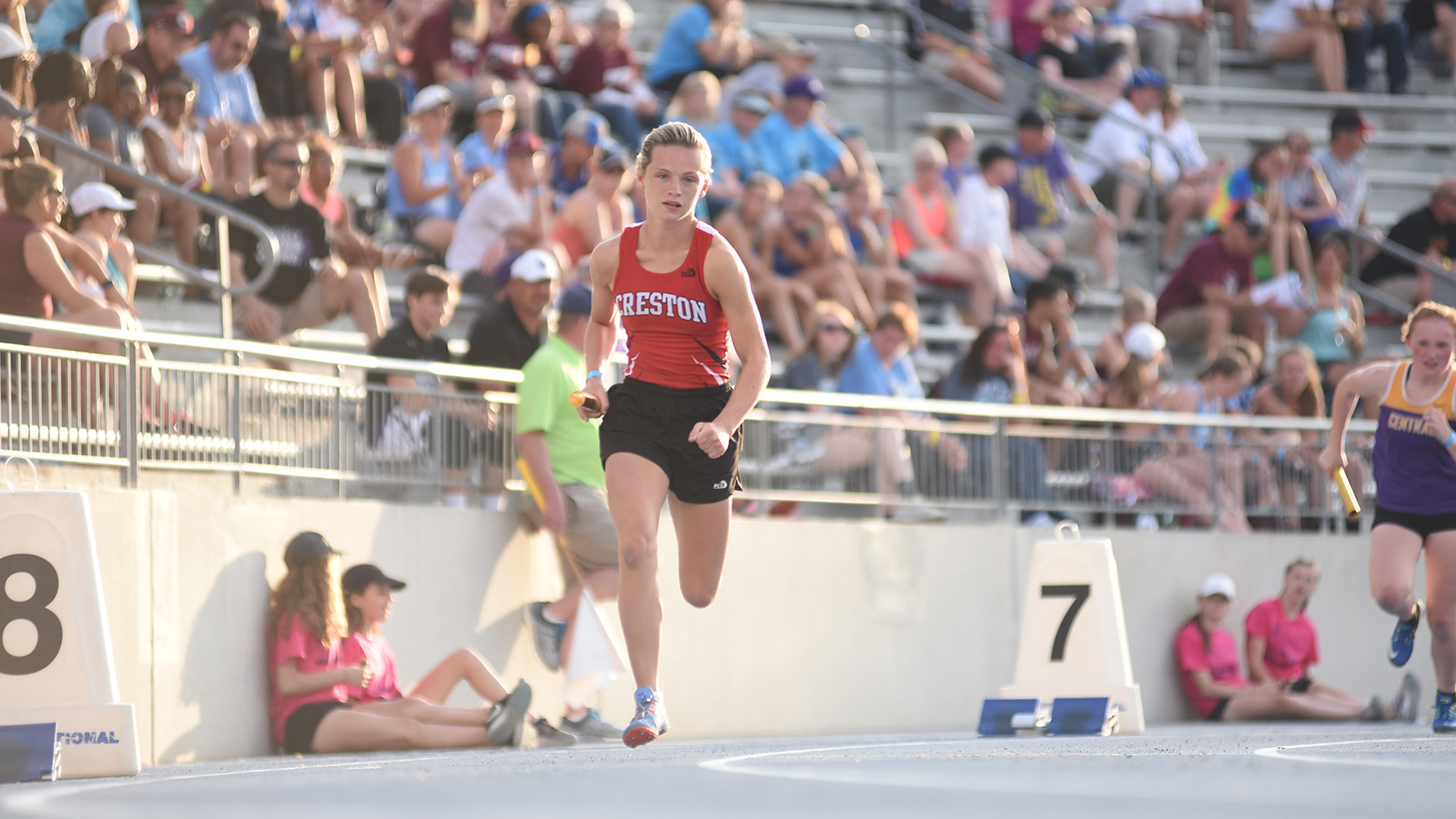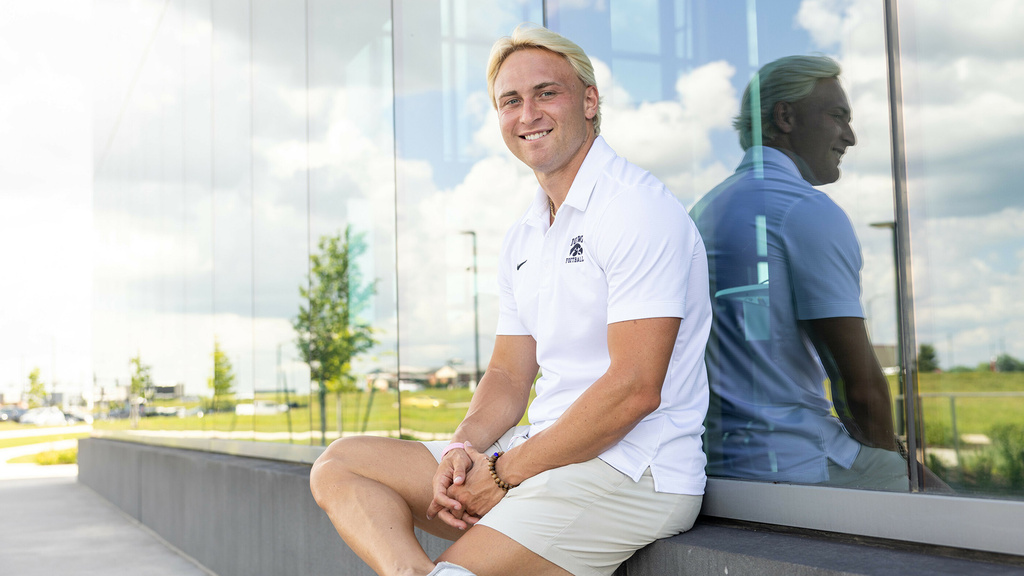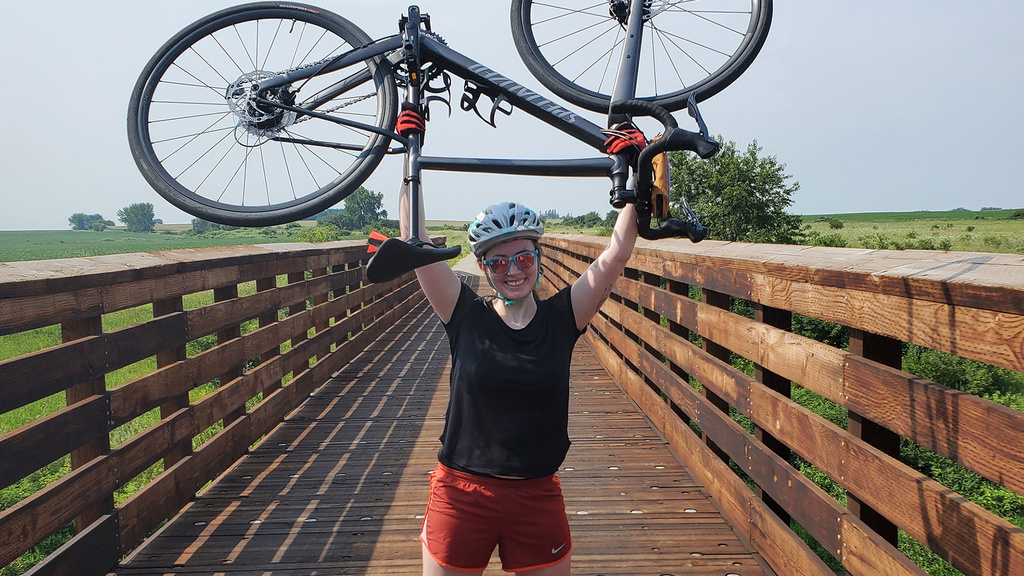When pain from hip dysplasia threatened to prevent Kiersten Latham from participating in her favorite activities, a team at University of Iowa Health Care worked with her to get her back in action.
Story: Emily Nelson and Tony Craine
Photography: Scott Vicker/Southwestern Community College
Published: Nov. 17, 2019
Kiersten Latham has been dancing almost as long as she’s been walking. At age 3, she was enrolled in dance classes at a local studio in her hometown of Creston, Iowa. Years later, she’s captain of the Dazzlers dance team at Southwestern Community College and teaches dance at two studios, including the one at which she got her start.
Although Kiersten makes the dance moves look easy, severe hip pain during high school nearly sidelined her permanently. With hard work, perseverance, and an advanced hip-preservation procedure available at just one place in Iowa — University of Iowa Health Care Medical Center — she’s dancing every day again with no plans to stop.
‘Something’s wrong with my hip’
As a dancer and a multi-sport athlete, Kiersten had been active her whole life. But problems started while playing volleyball during her first year of high school.
“I’ll never forget that day,” says Tammi Latham, Kiersten’s mother. “She was having a super game, so I was confused about why she had this death look on her face. Afterward, I could see the tears. She said, ‘Something’s wrong with my hip.’”
They visited a local orthopedic surgeon and learned that Kiersten had hip dysplasia, a condition in which the hip joint has not formed properly. The socket portion of the joint is too shallow to support the ball within it, resulting in intense pain, especially during activity. Left untreated, hip dysplasia can lead to arthritis.
While the diagnosis was upsetting enough, their local surgeon also told the Lathams that the procedure Kiersten needed — known as a periacetabular osteotomy (PAO) — requires specialty care that is not easy to find.
“He told us, ‘Kiersten needs to go further on. I can’t do anything for her,’” Tammi says. “He referred us to another orthopedic surgeon in Des Moines, but we heard the same thing there: ‘This is way beyond what we can handle.’ It was a very long process.”
Pushing through the pain
Meanwhile, Kiersten endured. She didn’t want to stop doing the things she loved, including dancing, playing softball and basketball, and running cross country and track.
“I pushed through it because I didn’t want to give up on anything,” Kiersten says. “I know the pain, and I know how much I can take.”
For relief, she had to frequently “pop” her hips back into place — a practice that became familiar to her teammates.
“There was not a time when you didn’t see me moving and popping my hips,” Kiersten says. “My teammates, they’d say, ‘If you pop it, it’s going to make it worse,’ but it actually feels better when I do it.”
Kiersten had to quit cross country in her junior year because the uneven terrain was too rough on her hips, but she continued to dance and compete in other sports, including making the state meet in track.
Individualized treatment for hip conditions
Your hips help you do more than you know. Whether you like to cook, play sports, or lounge around with a good book, you need healthy, pain-free hips to keep going. From routine cases to advanced procedures, University of Iowa Health Care’s team of hip preservation experts offers the most complete care for hips in Iowa. Our top priority is to provide care that is personalized for you.
Finding the right specialist
Then the Lathams learned about Michael Willey, MD, a University of Iowa Health Care orthopedic surgeon who specializes in PAO. Willey and orthopedic surgeon Robert Westermann, MD, offer a comprehensive young adult hip clinic that helps people like Kiersten get back to a normal life. It’s the only clinic in Iowa that offers PAO.
“He’s such a patient guy,” Tammi says of Willey. “I didn’t know what to expect. I probably asked him hundreds of questions. He reassured us that they were going to get her back to normal and back to doing the things she loves.”
As Kiersten prepared for surgery on the first hip during the summer between her junior and senior years of high school, she also had questions.
“There was a lot going through my mind,” Kiersten says. “I told him I had a goal to get back to dance, do track, and play softball. He was great to me. He told me if I followed his orders, I would get back and do those.”
Willey performed the PAO at UI Health Care Stead Family Children’s Hospital in July 2017 and then provided the guidance the Lathams needed to help Kiersten get through months of rehabilitation and achieve her goals.
“Kiersten was very dedicated to her rehab,” Willey says. “She was getting back to activities three to four months after surgery. We were really happy with how she recovered.”

Within a year of having her first procedure, Kiersten Latham returned to the state track meet, representing Creston High School in the distance medley and the 4x400 relay. “Kiersten was very dedicated to her rehab,” says Michael Willey, MD, a University of Iowa Health Care orthopedic surgeon who specializes in periacetabular osteotomy. “She was getting back to activities three to four months after surgery. We were really happy with how she recovered.”
From a wheelchair to crutches to a cane, Kiersten progressed through her recovery until she was finally allowed to do some light running. In late November of her senior year, she hit a milestone on her trip to full recovery when she competed in the state drill team competition.
One major goal remained: getting back to the state meet in track. The first meet of the season set the tone for the year when she ran the 400 meters in her fastest time ever.
“I just looked at her and said, ‘You’re back,’” Tammi says.
Later in the season, Kiersten’s relay team set a school record. And she did return to the state meet in two events: distance medley and 4x400 relay.
“I have chills just thinking about it,” Tammi says. “That was amazing.”
Achieving more goals after second surgery
Kiersten graduated from high school and enrolled at Southwestern Community College, where she continued to pursue her first love, dancing, with the Dazzlers and through teaching. She already knew she would need surgery on her other hip, but Kiersten says that hip got even worse during rehabilitation of the first hip, likely because she was putting more weight on it.
Surgery on the second hip took place in May 2019, and Kiersten says it went even better than the first.
“Obviously there was still pain, but I knew how to handle it a lot better,” Kiersten says. “I felt like I was able to do more faster, and I started physical therapy faster. It was a huge change.”
Kiersten and Tammi say the second surgery was a lot easier emotionally as well.
“She was a bit depressed and upset before the first surgery because she worried that she wouldn’t be able to dance,” Tammi says. “But after her first surgery, she set goals and made them. I think that helped with the second surgery, knowing she would get there again. It also helped having that medical community saying, ‘Hey, we’re going to get you there.’”
By fall, Kiersten was back with the Dazzlers. But it’s not only dancing in which Kiersten has noticed improvement since the surgeries on her hips. Even everyday activities that most people wouldn’t think about are easier.
“She can now sit in the car and not be so squirmy,” Tammi says. “She’s just a lot more comfortable.”

Kiersten Latham pursued her first love, dancing, during her first year at Southwestern Community College, performing with the Dazzlers. She had surgery on her other hip in May 2019, and was back with the Dazzlers by the fall.
Kiersten and Tammi want families who face a diagnosis similar to Kiersten’s to know there is hope.
“It’s a miracle she came back and she was still able to dance,” Tammi says. “Trust the doctors, and do the therapy and physical therapy faithfully. Set goals, including little goals you know you can reach. What can you do in two weeks? What can you do in one month? And be there for each other. You never want your child to go through anything difficult, but we got through this as a family.”
Kiersten has an additional piece of advice: “Don’t give up if you have a goal. Even though you may need surgery, you can still reach it.”
Kiersten now is setting her sights on new goals, knowing that whatever she does, she won’t have to worry about physical limitations. Those plans include pursuing elementary education next year at Grand View University in Des Moines, Iowa.
“I want to become a teacher, like my mom,” Kiersten says. “I want to teach younger kids. I like being around little kids. It’s not easy, but it’s fun.”
And of course, she’ll keep dancing.
“I’ll probably never stop dancing,” Kiersten says.



